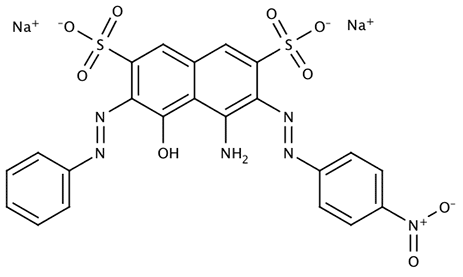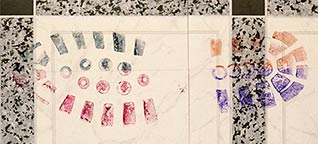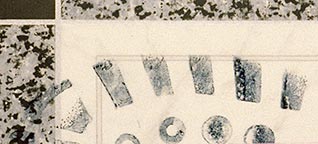Amido Black (Acid Black 1) is een kleurstof die eiwitten, zoals aanwezig in bloed, blauw-zwart kan kleuren. Amido Black wordt zowel op methanol basis als op water- en water/ethanol/azijnzuurbasis geleverd. Amido Black in methanol kleurt sterker, maar is door de giftigheid van de methanol ook gevaarlijker. Amido Black (Acid Black 1) is a dye that can stain proteins, such as those present in blood, blue-black. Amido Black can be supplied as methanol-based, water-based, and water/ethanol /acetic acid base. Amido Black in methanol stains more strongly than the water-based formulation, but is also more dangerous due to the toxicity of the methanol.
CAST's (The Centre for Applied Science and Technology - formerly part of the Home Office, now DSTL - UK) water/ethanol/acetic acid-based formulation stains as well as the methanol-based one. Especially for use on a crime scene (e.g. shoe marks in blood), the water/ethanol/acetic acid- or water-based Amido Black (the latter formulation stains less strongly) is therefore recommended.
When using Amido Black on porous or semi-porous surfaces, it is likely to give some background coloration. Amido Black does not fluoresce.
On what surfaces can it be used
Amido Black (Acid Black 1) is a blue-black dye used in various formulations on both non-porous, semi-porous and porous surfaces for staining traces in blood.
The formulations we offer are based on:
- methanol
- water/citric acid
- water, ethanol, and acetic acid [1]
The methanol-based one is the oldest (since the 1970s according to ref. 1), the acetic acid-based water/ethanol one the newest ([1], 2000). The CAST manual [2] recommends testing both Amido Black and Acid Violet 17 on a small piece of a porous or semi-porous item, away from where a trace is suspected, to see which of the two causes the least background staining.
Amido Black cannot be used after staining with Acid Yellow 7 [ref. 2, page 5-AD2]. It then stains much less strongly than Acid Violet 17.
Before using Amido Black, whatever formulation is used, the blood traces must first be fixed to avoid running through the trace (loss of detail).
Fixing blood traces
Fixation can be done with a 2% solution of 5-sulphosalicylic acid in water (20-23 grams in 1 litre of demi-water or distilled water). To ensure that the blood trace is well fixed, we recommend the following method that uses absorbent paper (such as filter paper, tissues, paper towels) and a spray bottle with sulphosalicylic acid solution.
Take a dry piece of absorbent paper large enough to cover the print to be fixed. Hold the paper above the print, parallel to the surface and then drop one side of the paper onto the surface (e.g. a short side if it is a shoe print). Soak this part with fixer solution all over the side, this part now acts as a kind of anchor.
Now wet the entire paper with the spray bottle, starting from the side that is already on/along the print, and keep lowering the wet part onto the print. This will prevent air bubbles from getting between the paper and the print as much as possible. Work slowly (the paper expands when it gets wet) and if the print is at an angle in the vertical plane (or can be kept that way) start on the high side and work down.
When the wet paper covers the entire track, leave it for 5 minutes. When the blood is a thick layer longer (deeper layers may not be fixed!). Then remove the paper. Fixative left on the trace can be washed away with water, but it is not necessary.
When the blood is relatively fresh, a colour change from dark red to dark brown will have occurred.
Method for staining
Once the print is fixed, it can be stained with the Amido Black solution. Use a spray bottle or wash bottle to apply the dye solution. With fingerprints, a pipette can be used or with an object of not too large size by dipping into a container/bath with dye solution.
Using a spray bottle has the disadvantage over using a wash bottle that methanol or ethanol vapour (depending on which formulation is used) will be released into the air. This is a health hazard in the case of methanol. Using a dust mask to prevent inhalation of the spray mist is also recommended.
After the dye solution is applied, leave it in contact with the print for about 3 minutes. Then rinse the surface with the same solvent mixture as used for the dye solution.
Methanol/acetic acid in the case of the methanol formulation, water or water with vinegar or citric acid in the case of the water-based formulation and water/ethanol/acetic acid in the case of the that formulation. For the methanol/acetic acid-based formulation, there is a second rinsing solution: a 5% acetic acid solution (vinegar).
If the prints are on the floor, the rinsing solution can also be sucked away with a wet and dry vacuum cleaner. Absorbent paper as applied in fixation can also be used to collect the liquid. Blowing away the solutions with an air jet is also an option.
Lifting
Prints stained with Amido Black do not fluoresce, neither after lifting with a white gelatin lifter. Lifting enables the elemination of backgrounds and/or background fluorescence.
Before lifting can be done with a white gelatin lifter the print (on a non-porous surface) needs to be dry. When applying the lifter make absolutely sure that are no air bubbles trapped between the stained print and the lifter. Leave the lifter on for quite some time, in the order of 15 minutes. Photografing the lifted print should be done within a few hours. This is because the dye will slowly diffuse through the lifter in all directions. The print will lose sharpness as a result.
Lifting the print can be done several times, with or without re-staining in between. In important cases, it is advisable to try lifting and re-staining several times.
Safety
Amido Black powder is irritating to the skin, eyes and respiratory tract and can cause serious eye damage/eye irritation. In solution, of course, there is no longer a respiratory hazard but eye protection is definitely recommended. Depending on the formulation, there is vapour hazard (not with the water/citric acid-based Amido Black solution). In fact, the methanol formulation can only be used in a fume cupboard. On a crime scene, the methanol vapour is too dangerous.
The working solutions and rinsing solution based on the water-ethanol mixture will not form harmful vapours in normal use, although the vinegar smell may be irritating. When using large quantities or when the temperature is high enough, a potentially explosive ethanol-air mixture may be formed with insufficient ventilation. Furthermore, Amido Black solutions stain skin and clothing. Use of gloves is therefore necessary (nitrile gloves with the methanol formulation).
5-Sulfosalicylic acid powder has been characterised as an irritant, but the 2% solution is not a dangerous mixture. However, given its fixing effect on blood, we still recommend wearing gloves (nitrile, vinyl or latex gloves suffice) when using it. Use of goggles is also advisable.
Avoid inhaling sprays (aerosols). By the way, the fixative solution does not emit fumes. Wash hands after every use of fixative, dye or rinse solution, especially before eating or drinking.
Composition of solutions
Methanol-based Amido Black
| 2 grams | Amido Black |
| 100 ml | acetic acid ("glacial acetic acid", 99%) |
| 900 ml | methanol (98% or higher) |
| -------- | |
| 1000 ml | working solution |
Preferable use an Erlenmeyer flask for making the Amido Black solution. The order in which methanol and acetic acid are added to the weighed amount of Amido Black powder is not important. Dissolve it using a magnetic stirrer and a stirring bar (magnet covered with PTFE). The powder dissolves slowly but the strong colour of the solution will make it difficult to see. Take enough time to allow the powder to dissolve (half an hour, for example).
For the methanol-based rinsing solution, the same quantities of solvent as for the working solution are used with omission of the Amido Black powder.
The second rinsing solution (5% vinegar) is made by diluting 50 ml of glacial acetic acid with 950 ml of demineralised or distilled water.
Water/ethanol/acetic acid-based Amido Black
| 1 gram | Amido Black |
| 50 ml | acetic acid ("glacial acetic acid", 99%) |
| 250 ml | ethanol (98% or higher) |
| 700 ml | demineralised or distilled water |
| -------- | |
| 1000 ml | working solution |
Preferable use an Erlenmeyer flask for making the Amido Black solution. The order in which methanol and acetic acid are added to the weighed amount of Amido Black powder is not important. Dissolve it using a magnetic stirrer and a stirring bar (magnet covered with PTFE). The powder dissolves slowly but the strong colour of the solution will make it difficult to see. Take enough time to allow the powder to dissolve (half an hour, for example).
For the water/ethanol/acetic acid-based rinsing solution, the same volumes of solvent as for the working solution are used with the omission of the Amido Black powder.
Blood fixative
| 20-23 grams | 5-sulfosalicylic acid, dihydrate |
| 1000 ml | demineralised or distilled water |
| -------- | |
| 1000 ml | working solution |
Add the components together in a beaker or flask/bottle of sufficient size and mix until everything is dissolved. Use of a magnetic stirrer with stirring bar is recommended.
References and footnotes
[1] Sears, V.G.; Prizeman, T.M. "Enhancement of Fingerprints in Blood - Part 1: The Optimization of Amido Black" Journal of Forensic Identification 2000, Vol. 50, nr. 5, p. 470-480.
[2] Fingermark Visualisation Manual, Chapter 5.PD ISBN: 978-1-78246-234-7, Home Office, January 2014. No longer available at The Stationary Office.

Name: Amido Black 10B, Acid Black 1, Naphthol Blue Black, CI 20470, 4-Amino-5-hydroxy-3-(p-nitrophenylazo)-6-(phenylazo)-2,7-naphthalenedisulfonic acid disodium salt
CAS No.: 1064-48-8









